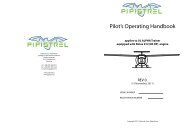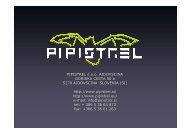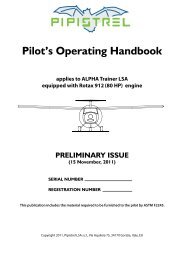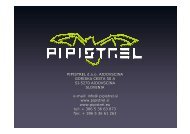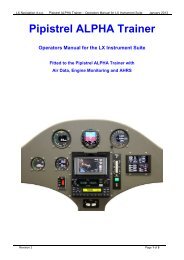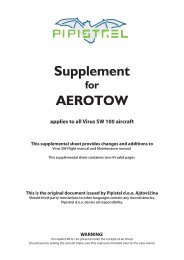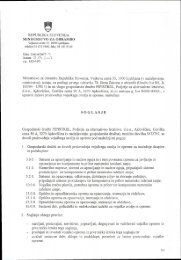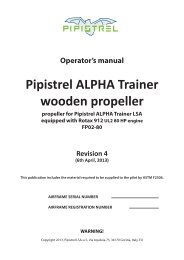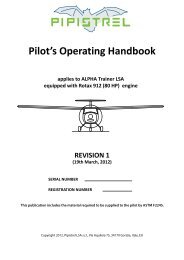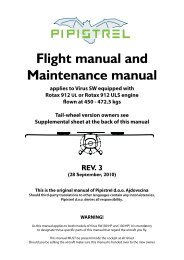Create successful ePaper yourself
Turn your PDF publications into a flip-book with our unique Google optimized e-Paper software.
www.pipistrel.eu<br />
<strong>ALPHA</strong> <strong>Trainer</strong> 7-5<br />
Normal procedures REV. 0<br />
Cockpit preflight inspection<br />
Instrument panel and instruments: checked<br />
Battery disconnection lever: in position for battery operation (lever deflected towards the firewall)<br />
Master switch OFF: no control lights and/or electronic instrument activity<br />
Master switch ON: generator fail light on (engine not running!)<br />
Make sure you have set all instruments to correct initial setting.<br />
Main wing spars and connectors: no visible abnormalities of metal parts, spars, pins and bolts; all<br />
bolts and nuts in position and tightened<br />
Fuel hoses, pitot-static lines and electrical cables: correctly connected and in position<br />
Transparent plastic providing visual fuel quantity monitoring: clean with no cracks<br />
Safety belts: undamaged, verify unobstructed harness opening; fastening points intact<br />
Doors and windshield: perfect closing at all three points, smooth opening, hinges firmly attached;<br />
glass immaculately clean with no cracks.<br />
Flap handle: button spring firm, locking mechanism working properly, smooth movement along full<br />
deflections, no free play or visible damage.<br />
Radio wiring: test the switches, check connectors and headset, perform radio check<br />
Battery (some models): firmly in position, joints clean with wires connected<br />
Emergency parachute release handle (optional): safety pin removed.<br />
Elevator trim: verify travel and set neutral before start-up.<br />
Make sure unobstructed access is provided.<br />
Normal procedures<br />
and recommended speeds<br />
To enter the cabin first lift the door all the way to the bottom wing surface. The silver knob will grab<br />
and secure the glass door in position. Sit onto the cabin’s edge and support your body by placing<br />
hands onto this same cabin edge. Drag yourself into the seat, lifting only one leg over the stick for<br />
best position. Immediately after having sat into the seat, check rudder pedals’ position to suit your<br />
size and needs. The position of pedals is adjustable also during flight.<br />
To lower the door DO NOT attempt to grab and pull door’s handle but gently pull the silver knob<br />
instead. To close the door securely, rotate the handle so that it locks and verify that all three closing<br />
points are secured.<br />
Fasten the safety belts according to your size.<br />
Adjust the rudder pedals according to your required legroom. Sit inside the cockpit and release the<br />
pressure off the pedals. Pull the black knob in front of the control stick to bring the pedals closer to<br />
you. To move the pedals further away, first release the pressure of the pedals, then pull on the knob<br />
slightly (this will release the lock in the mechanism). Now push the pedals forward using with your<br />
feet, while keeping the black adjusment knob in your hand.<br />
WARNING! The safety harness must hold you in your seat securely. This is especially important<br />
when flying in rough air, as otherwise you may bump into the tubes and/or spars overhead.<br />
Make sure you tighten the bottom straps first, then shoulder straps.





